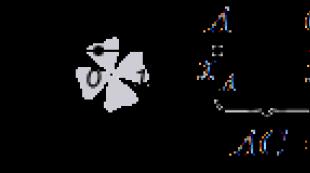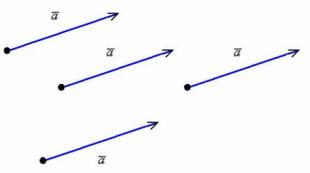How to find the length of a segment if the coordinates are known. Finding the coordinates of the middle of the segment, examples, solutions. Method of coordinates in space
In this article, we will talk about finding the coordinates of the middle of a segment from the coordinates of its ends. First, we will give the necessary concepts, then we will obtain formulas for finding the coordinates of the middle of a segment, and in conclusion, we will consider solutions to typical examples and problems.
Page navigation.
The concept of the middle of a segment.
In order to introduce the concept of the midpoint of a segment, we need definitions of a segment and its length.
The concept of a segment is given in mathematics lessons in the fifth grade of high school as follows: if we take two arbitrary non-coinciding points A and B, attach a ruler to them and draw a line from A to B (or from B to A), then we get segment AB(or segment B A). Points A and B are called the ends of the segment. We should keep in mind that segment AB and segment BA are the same segment.
If the segment AB is infinitely extended in both directions from the ends, then we get straight line AB(or direct VA). Segment AB is the part of the straight line AB enclosed between points A and B. Thus, the segment AB is the union of points A, B and the set of all points of the straight line ABlocated between points A and B. If we take an arbitrary point M of the straight line AB located between points A and B, then they say that the point M lies on segment AB.
Length of segment AB is the distance between points A and B at a given scale (segment of unit length). The length of the segment AB will be denoted as .
Definition.
Dot C is called the middle of the segment AB if it lies on the segment AB and is at the same distance from its ends.
That is, if point C is the midpoint of the segment AB, then it lies on it and.
Further, our task will be to find the coordinates of the middle of the segment AB if the coordinates of points A and B are given on the coordinate line or in a rectangular coordinate system.
The coordinate of the midpoint of the segment on the coordinate line.
Let us be given a coordinate line Ox and two non-coinciding points A and B on it, which correspond to real numbers and . Let point C be the midpoint of segment AB. Let's find the coordinate of the point C.

Since point C is the midpoint of the segment AB, then the equality is true. In the section on the distance from a point to a point on a coordinate line, we showed that the distance between points is equal to the modulus of the difference between their coordinates, therefore, . Then ![]() or
or ![]() . From equality
. From equality ![]() find the coordinate of the midpoint of the segment AB on the coordinate line:
find the coordinate of the midpoint of the segment AB on the coordinate line: ![]() - it is equal to half the sum of the coordinates of the ends of the segment. From the second equality
- it is equal to half the sum of the coordinates of the ends of the segment. From the second equality ![]() we get , which is impossible, since we took non-coinciding points A and B.
we get , which is impossible, since we took non-coinciding points A and B.
So, the formula for finding the coordinate of the midpoint of the segment AB with ends and has the form .
Coordinates of the midpoint of a line segment.
Let us introduce a rectangular Cartesian coordinate system Оxyz on the plane. Let us be given two points and and we know that the point C is the midpoint of the segment AB. Let's find the coordinates and points C.

By construction, straight ![]() parallel as well as parallel lines
parallel as well as parallel lines ![]() , therefore, by Thales theorem from the equality of the segments AC and CB follows the equality of the segments and , as well as the segments and . Therefore, the point is the midpoint of the segment, and the midpoint of the segment. Then, by virtue of the previous paragraph of this article
, therefore, by Thales theorem from the equality of the segments AC and CB follows the equality of the segments and , as well as the segments and . Therefore, the point is the midpoint of the segment, and the midpoint of the segment. Then, by virtue of the previous paragraph of this article ![]() And
And ![]() .
.
Using these formulas, one can also calculate the coordinates of the middle of the segment AB in cases where points A and B lie on one of the coordinate axes or on a straight line perpendicular to one of the coordinate axes. Let us leave these cases without comment, and give graphic illustrations.


In this way, the midpoint of segment AB on a plane with ends at points and has coordinates  .
.
Coordinates of the middle of the segment in space.
Let a rectangular coordinate system Oxyz be introduced in three-dimensional space and two points ![]() And
And ![]() . We get formulas for finding the coordinates of the point C, which is the midpoint of the segment AB.
. We get formulas for finding the coordinates of the point C, which is the midpoint of the segment AB.
Let's consider the general case.
Let and be the projections of points A, B, and C onto the coordinate axes Ox, Oy, and Oz, respectively.

By Thales' theorem, therefore, the points are the midpoints of the segments ![]() respectively. Then (see the first paragraph of this article). So we got formulas for calculating the coordinates of the middle of a segment from the coordinates of its ends in space.
respectively. Then (see the first paragraph of this article). So we got formulas for calculating the coordinates of the middle of a segment from the coordinates of its ends in space.
These formulas can also be used in cases where points A and B lie on one of the coordinate axes or on a straight line perpendicular to one of the coordinate axes, and also if points A and B lie in one of the coordinate planes or in a plane parallel to one of the coordinate axes. planes.
The coordinates of the middle of the segment through the coordinates of the radius vectors of its ends.
Formulas for finding the coordinates of the middle of a segment are easy to obtain by referring to the algebra of vectors.
Let a rectangular Cartesian coordinate system Oxy be given on the plane and point C be the midpoint of the segment AB , and and .
According to the geometric definition of operations on vectors, the equality  (point C is the point of intersection of the diagonals of a parallelogram built on vectors and , that is, point C is the midpoint of the diagonal of the parallelogram). In the article coordinates of a vector in a rectangular coordinate system, we found out that the coordinates of the radius vector of a point are equal to the coordinates of this point, therefore,
(point C is the point of intersection of the diagonals of a parallelogram built on vectors and , that is, point C is the midpoint of the diagonal of the parallelogram). In the article coordinates of a vector in a rectangular coordinate system, we found out that the coordinates of the radius vector of a point are equal to the coordinates of this point, therefore, ![]() . Then, after performing the corresponding operations on vectors in coordinates , we have . How can we conclude that point C has coordinates
. Then, after performing the corresponding operations on vectors in coordinates , we have . How can we conclude that point C has coordinates  .
.
Absolutely similarly, the coordinates of the middle of the segment AB can be found through the coordinates of its ends in space. In this case, if C is the midpoint of the segment AB and , then we have  .
.
Finding the coordinates of the middle of the segment, examples, solutions.
In many problems, you have to use formulas to find the coordinates of the midpoint of a segment. Let's consider solutions of the most characteristic examples.
Let's start with an example that only needs to apply a formula.
Example.
The coordinates of two points are given on the plane ![]() . Find the coordinates of the midpoint of the segment AB.
. Find the coordinates of the midpoint of the segment AB.
Solution.
Let point C be the midpoint of segment AB. Its coordinates are equal to half-sums of the corresponding coordinates of points A and B: 
Thus, the midpoint of the segment AB has coordinates.
If you touch a notebook sheet with a well-sharpened pencil, a trace will remain that gives an idea of the point. (Fig. 3).
We mark two points A and B on a sheet of paper. These points can be connected by various lines ( fig. 4). And how to connect points A and B with the shortest line? This can be done using a ruler ( fig. 5). The resulting line is called segment.
Point and Line - Examples geometric shapes.
Points A and B are called the ends of the segment.
There is a single segment whose ends are points A and B. Therefore, a segment is denoted by writing down the points that are its ends. For example, the segment in Figure 5 is designated in one of two ways: AB or BA. Read: "segment AB" or "segment BA".
Figure 6 shows three segments. The length of the segment AB is equal to 1 cm. It is placed exactly three times in the segment MN, and exactly 4 times in the segment EF. We will say that segment length MN is 3 cm, and the length of segment EF is 4 cm.
It is also customary to say: "segment MN is 3 cm", "segment EF is 4 cm". They write: MN = 3 cm, EF = 4 cm.
We measured the lengths of the segments MN and EF single segment, the length of which is 1 cm. To measure segments, you can choose other units of length, for example: 1 mm, 1 dm, 1 km. In figure 7, the length of the segment is 17 mm. It is measured by a single segment, the length of which is 1 mm, using a ruler with divisions. Also, using a ruler, you can build (draw) a segment of a given length (see fig. 7).
At all, to measure a segment means to count how many unit segments fit in it.
The length of a segment has the following property.
If point C is marked on segment AB, then the length of segment AB is equal to the sum of the lengths of segments AC and CB(Fig. 8).
They write: AB = AC + CB.
Figure 9 shows two segments AB and CD. These segments will coincide when superimposed.
Two segments are called equal if they coincide when superimposed.
Hence the segments AB and CD are equal. They write: AB = CD.
Equal segments have equal lengths.
Of the two unequal segments, we will consider the one with the longer length to be larger. For example, in Figure 6, segment EF is larger than segment MN.
The length of segment AB is called distance between points A and B.
If several segments are arranged as shown in Figure 10, then a geometric figure will be obtained, which is called broken line. Note that all the segments in Figure 11 do not form a broken line. It is believed that segments form a broken line if the end of the first segment coincides with the end of the second, and the other end of the second segment coincides with the end of the third, etc.
Points A, B, C, D, E − polyline vertices ABCDE, points A and E − broken line ends, and the segments AB, BC, CD, DE are its links(see fig. 10).
The length of the broken line is the sum of the lengths of all its links.
Figure 12 shows two broken lines, the ends of which coincide. Such broken lines are called closed.
Example 1 . Segment BC is 3 cm less than segment AB, the length of which is 8 cm (Fig. 13). Find the length of segment AC.
Solution. We have: BC \u003d 8 - 3 \u003d 5 (cm).
Using the property of the length of a segment, we can write AC = AB + BC. Hence AC = 8 + 5 = 13 (cm).
Answer: 13 cm.
Example 2 . It is known that MK = 24 cm, NP = 32 cm, MP = 50 cm (Fig. 14). Find the length of the segment NK.
Solution. We have: MN = MP − NP.
Hence MN = 50 − 32 = 18 (cm).
We have: NK = MK − MN.
Hence NK = 24 − 18 = 6 (cm).
Answer: 6 cm.
The length, as already noted, is indicated by the modulus sign.
If two points of the plane and are given, then the length of the segment can be calculated by the formula
If two points in space and are given, then the length of the segment can be calculated by the formula
Note:The formulas will remain correct if the corresponding coordinates are swapped: and , but the first option is more standard
Example 3
Solution: according to the corresponding formula:
Answer:
For clarity, I will make a drawing
Section - it's not a vector, and you can't move it anywhere, of course. In addition, if you complete the drawing to scale: 1 unit. \u003d 1 cm (two tetrad cells), then the answer can be checked with a regular ruler by directly measuring the length of the segment.
Yes, the solution is short, but there are a couple of important points in it that I would like to clarify:
First, in the answer we set the dimension: “units”. The condition does not say WHAT it is, millimeters, centimeters, meters or kilometers. Therefore, the general formulation will be a mathematically competent solution: “units” - abbreviated as “units”.
Secondly, let's repeat the school material, which is useful not only for the considered problem:
pay attention to important technical trick – taking the multiplier out from under the root. As a result of the calculations, we got the result and good mathematical style involves taking the multiplier out from under the root (if possible). The process looks like this in more detail: Of course, leaving the answer in the form will not be a mistake - but it is definitely a flaw and a weighty argument for nitpicking on the part of the teacher.
Here are other common cases:
Often a sufficiently large number is obtained under the root, for example. How to be in such cases? On the calculator, we check if the number is divisible by 4:. Yes, it was completely divided, thus: . Or maybe the number can be divided by 4 again? . In this way: . The last digit of the number is odd, so dividing by 4 for the third time is clearly not possible. Trying to divide by nine: . As a result:
Ready.
Output: if under the root we get a whole number that cannot be extracted, then we try to take out the factor from under the root - on the calculator we check whether the number is divisible by: 4, 9, 16, 25, 36, 49, etc.
In the course of solving various problems, roots are often found, always try to extract factors from under the root in order to avoid a lower score and unnecessary troubles with finalizing your solutions according to the teacher's remark.
Let's repeat the squaring of the roots and other powers at the same time:
The rules for actions with degrees in a general form can be found in a school textbook on algebra, but I think that everything or almost everything is already clear from the examples given.
Task for an independent solution with a segment in space:
Example 4
Given points and . Find the length of the segment.
Solution and answer at the end of the lesson.
The length of a segment can be determined in different ways. In order to find out how to find the length of a segment, it is enough to have a ruler available or know special formulas for calculating.
Line length with ruler
To do this, we apply a ruler with millimeter divisions to the segment built on the plane, and the starting point must be aligned with the zero of the ruler scale. Then you should mark on this scale the location of the end point of this segment. The resulting number of whole divisions of the scale will be the length of the segment, expressed in cm and mm.
Plane coordinate method
If the coordinates of the segment (x1; y1) and (x2; y2) are known, then its length should be calculated as follows. From the coordinates on the plane of the second point, the coordinates of the first point should be subtracted. The result should be two numbers. Each of these numbers must be squared, and then find the sum of these squares. From the resulting number, the square root should be extracted, which will be the distance between the points. Since these points are the ends of the segment, this value will be its length.
Consider an example of how to find the length of a segment by coordinates. There are coordinates of two points (-1;2) and (4;7). When finding the difference in the coordinates of the points, we obtain the following values: x = 5, y = 5. The resulting numbers will be the coordinates of the segment. Then we square each number and find the sum of the results, it is 50. From this number we extract the square root. The result is: 5 roots of 2. This is the length of the segment.
Method of coordinates in space
To do this, consider how to find the length of a vector. It is he who will be a segment in Euclidean space. It is found in almost the same way as the length of a segment on a plane. The construction of the vector occurs in different planes. How to find the length of a vector?
- Find the coordinates of the vector, for this, from the coordinates of its end point, you need to subtract the coordinates of its start point.
- After that, you need to square each coordinate of the vector.
- Then add the squares of the coordinates.
- To find the length of a vector, you need to take the square root of the sum of the squares of the coordinates.
Let's consider the calculation algorithm using an example. It is necessary to find the coordinates of the vector AB. Points A and B have the following coordinates: A (1;6;3) and B (3;-1;7). The beginning of the vector lies at point A, the end is located at point B. Thus, to find its coordinates, it is necessary to subtract the coordinates of point A from the coordinates of point B: (3 - 1; -1 - 6; 7 - 3) = (2; - 7;4).
Now we square each coordinate and add them: 4+49+16=69. Finally, extracts the square root of the given number. It is difficult to extract it, so we write the result in this way: the length of the vector is equal to the root of 69.
If it’s not important for you to calculate the length of segments and vectors yourself, but you just need the result, then you can use an online calculator, for example, this one.
Now, having studied these methods and having considered the presented examples, you can easily find the length of the segment in any problem.
segment call the part of a straight line consisting of all the points of this line that are located between the given two points - they are called the ends of the segment.
Let's consider the first example. Let a certain segment be given in the coordinate plane by two points. In this case, we can find its length by applying the Pythagorean theorem.
So, in the coordinate system, draw a segment with the given coordinates of its ends(x1; y1) And (x2; y2) . on axle X And Y drop perpendiculars from the ends of the segment. Mark in red the segments that are projections from the original segment on the coordinate axis. After that, we transfer the projection segments parallel to the ends of the segments. We get a triangle (rectangular). The hypotenuse of this triangle will be the segment AB itself, and its legs are the transferred projections.
Let's calculate the length of these projections. So on the axis Y projection length is y2-y1 , and on the axis X projection length is x2-x1 . Let's apply the Pythagorean theorem: |AB|² = (y2 - y1)² + (x2 - x1)² . In this case |AB| is the length of the segment.
If you use this scheme to calculate the length of a segment, then you can even not build a segment. Now we calculate what is the length of the segment with coordinates (1;3) And (2;5) . Applying the Pythagorean theorem, we get: |AB|² = (2 - 1)² + (5 - 3)² = 1 + 4 = 5 . And this means that the length of our segment is equal to 5:1/2 .
Consider the following method for finding the length of a segment. To do this, we need to know the coordinates of two points in some system. Consider this option using a two-dimensional Cartesian coordinate system.

So, in a two-dimensional coordinate system, the coordinates of the extreme points of the segment are given. If we draw straight lines through these points, they must be perpendicular to the coordinate axis, then we get a right triangle. The original segment will be the hypotenuse of the resulting triangle. The legs of the triangle form segments, their length is equal to the projection of the hypotenuse on the coordinate axes. Based on the Pythagorean theorem, we conclude: in order to find the length of a given segment, you need to find the lengths of the projections on two coordinate axes.
Find the projection lengths (X and Y) the original segment to the coordinate axes. We calculate them by finding the difference in the coordinates of points along a separate axis: X=X2-X1, Y=Y2-Y1 .
Calculate the length of the segment BUT , for this we find the square root:
A = √(X²+Y²) = √((X2-X1)²+(Y2-Y1)²) .
If our segment is located between points whose coordinates 2;4 And 4;1 , then its length, respectively, is equal to √((4-2)²+(1-4)²) = √13 ≈ 3.61 .













